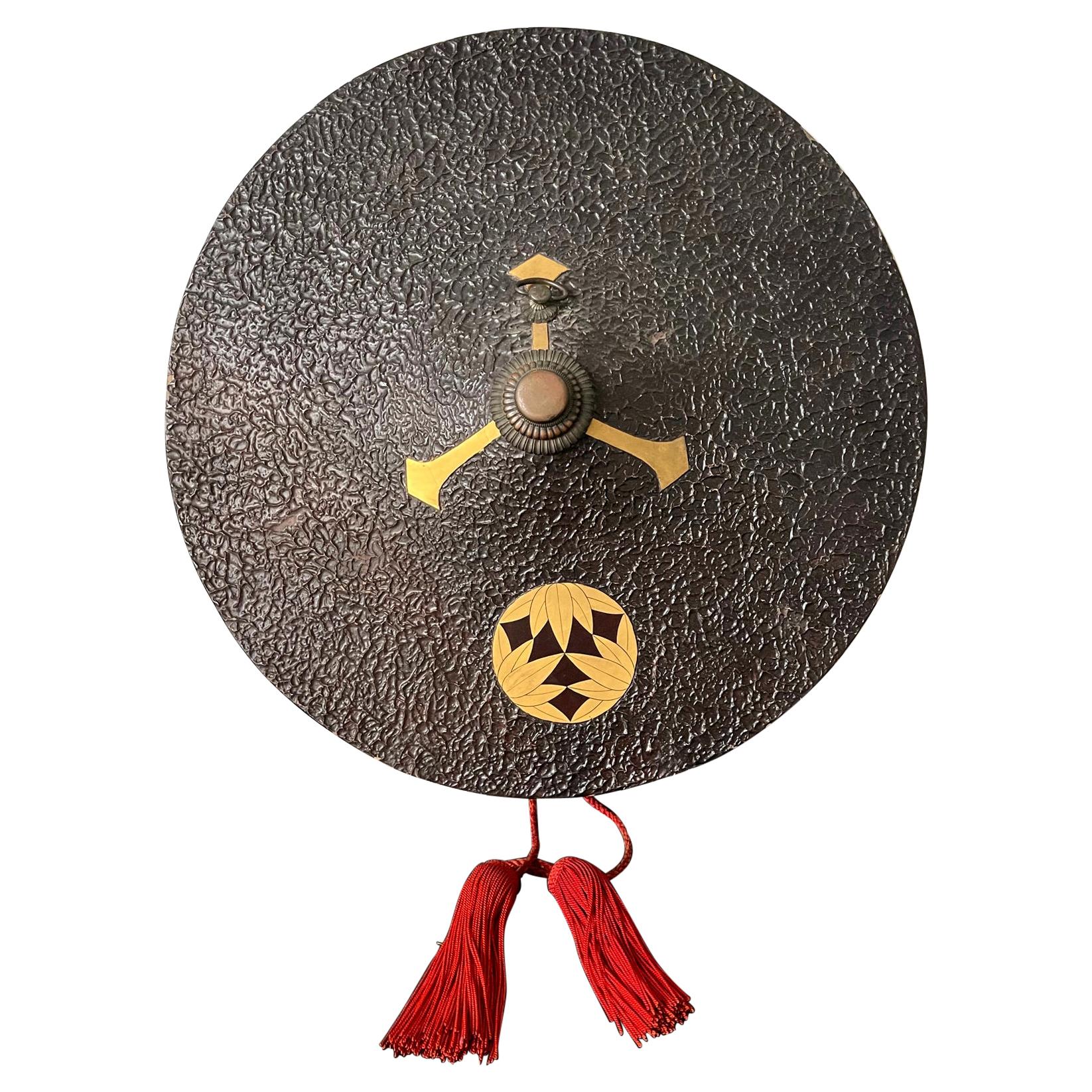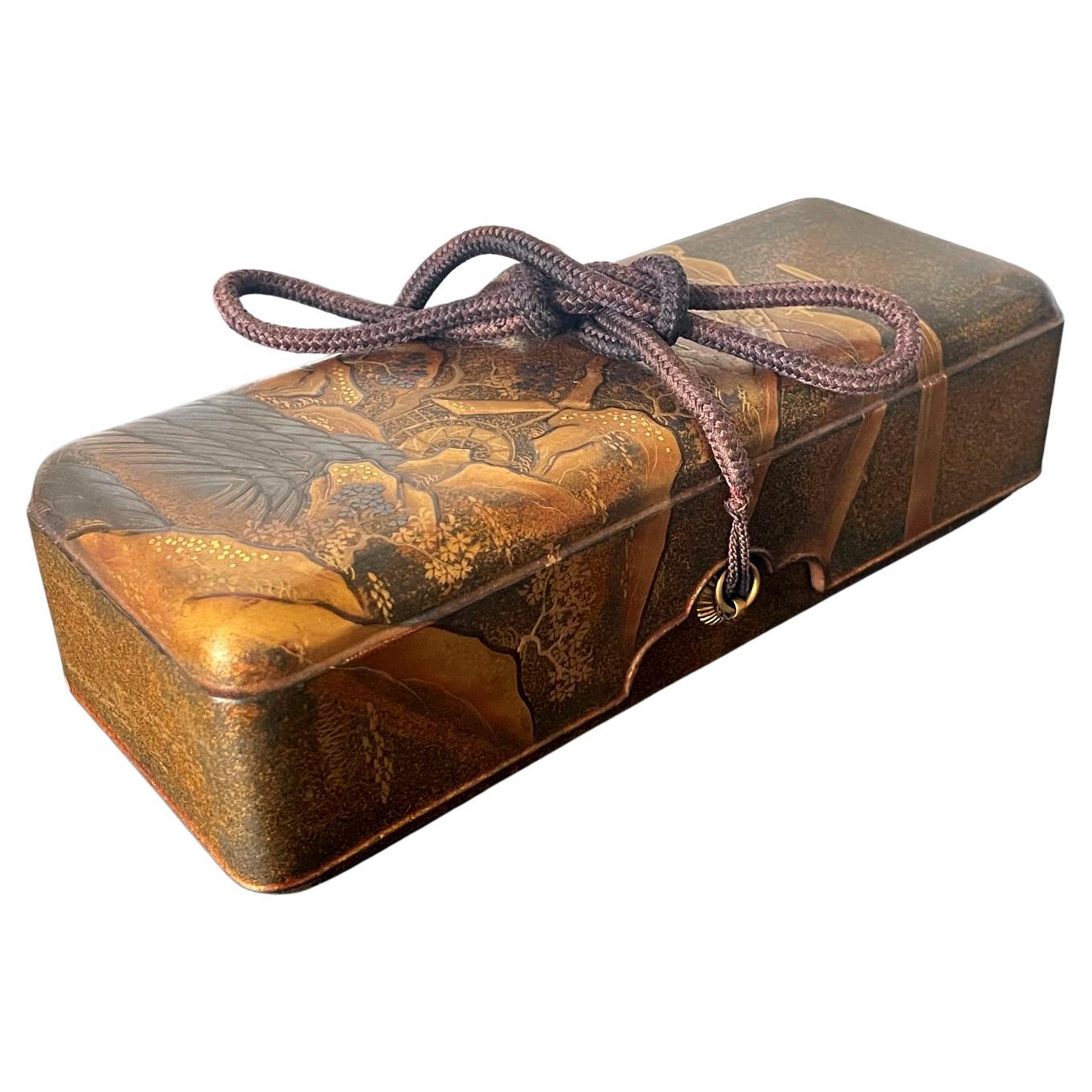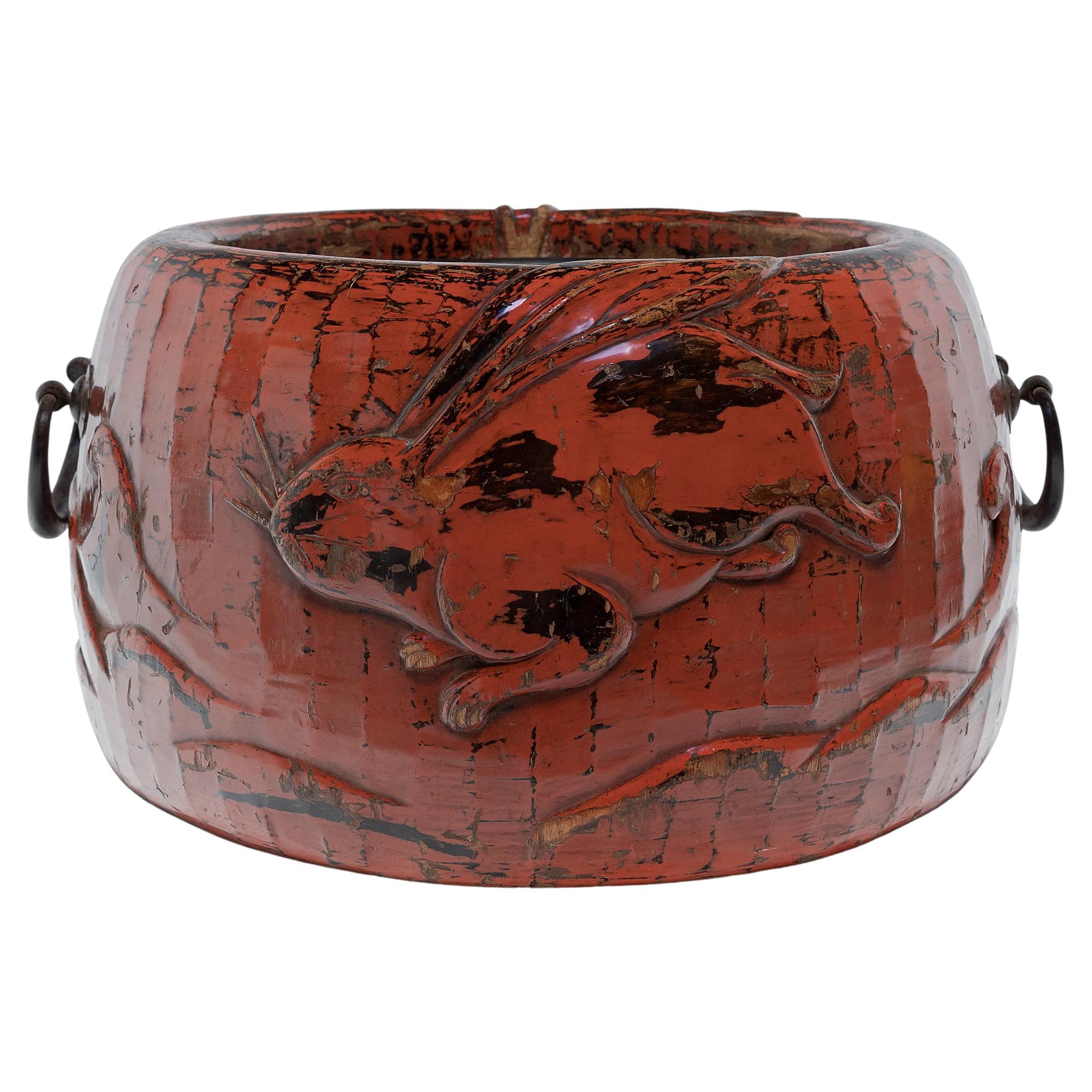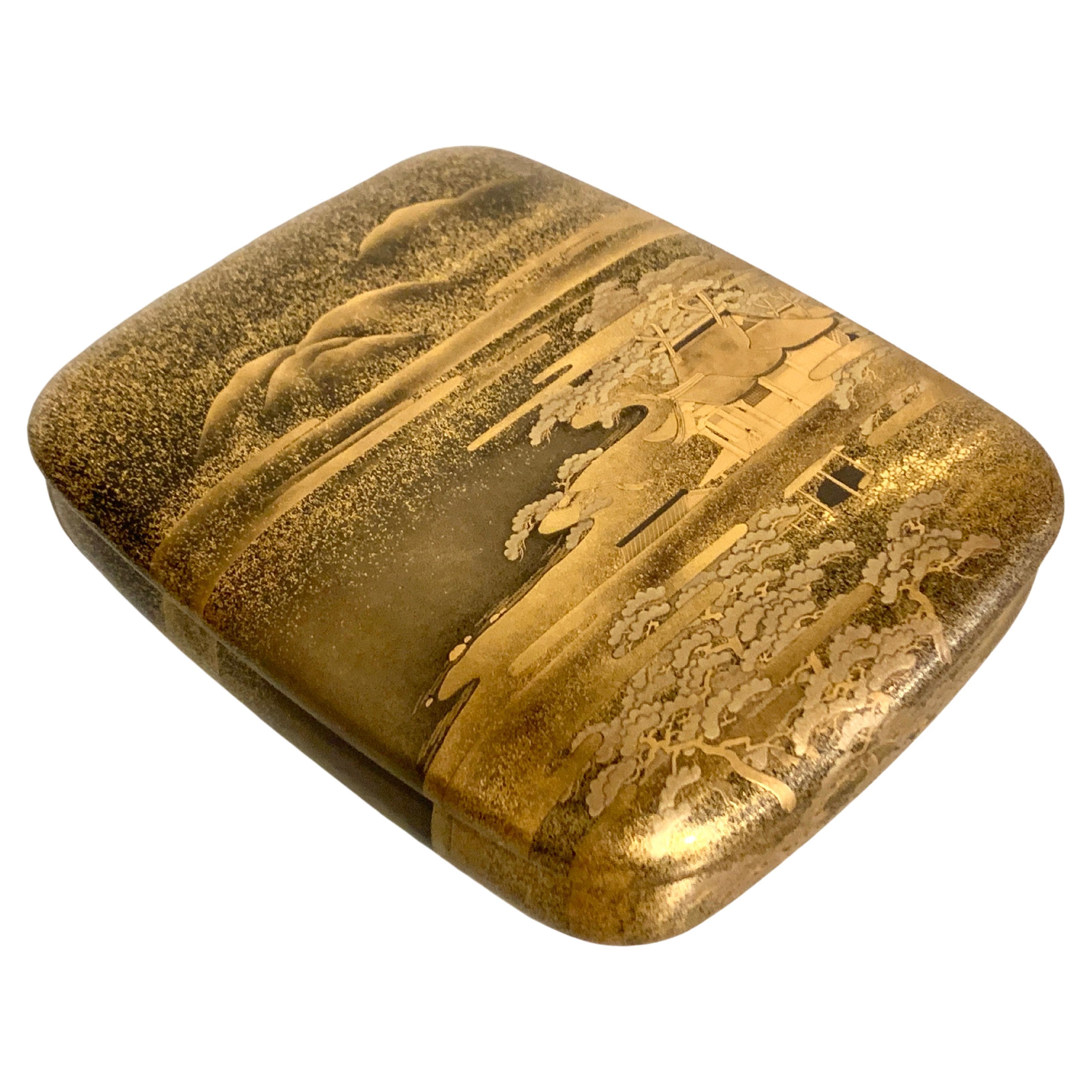Items Similar to Edo-Period Lacquered Jingasa
Want more images or videos?
Request additional images or videos from the seller
1 of 5
Edo-Period Lacquered Jingasa
About the Item
Complete with a lacquered surface and original silk straps, this Japanese Edo-period traveling hat, or jingasa, first emerged during the illustrious period between 1603 and 1868, a time when peace and art flourished. Crafted in the 19th century and once worn by members of the esteemed samurai class, this hat symbolized the wearer's identity, honor and social standing. Adorned with a chrysanthemum, the imperial symbol, this remarkable accessory is a stunning representation of a bygone era.
The traditional jingasa shape and structure are designed to shield the wearer from the elements, all while showcasing the meticulous craftsmanship that has allowed it to retain its integrity through the centuries. The creation of a lacquered hat such as this would have been an incredibly time-consuming process; the art form is considered among the most labor-intensive in the world and requires an exceptional level of finesse.
16" diameter (40.64 cm)
About the Seller
5.0
Recognized Seller
These prestigious sellers are industry leaders and represent the highest echelon for item quality and design.
Established in 1912
1stDibs seller since 2010
93 sales on 1stDibs
Typical response time: 7 hours
- ShippingRetrieving quote...Ships From: New Orleans, LA
- Return PolicyA return for this item may be initiated within 7 days of delivery.
More From This SellerView All
- Japanese Lacquer TrayLocated in New Orleans, LAAs beautiful as it is practical, this Japanese Meiji-period lacquered tray is distinguished by its exceptional craftsmanship. It exhibits a phenomenal artistry as the entire tray is ...Category
Early 20th Century Japanese Meiji Lacquer
MaterialsLacquer
- Japanese Lacquer TrayLocated in New Orleans, LAHailing from illustrious Meiji-period Japan, this lacquer tray showcases the mastery of Japanese craftsmen. Precious materials are precisely inlaid in the lacquer base, creating an a...Category
Antique Late 19th Century Japanese Meiji Lacquer
MaterialsSilver
- Japanese Lacquer BoxLocated in New Orleans, LAThis exquisite Meiji-period lacquer document box known as a ryoshibako showcases the meticulous artistry of maki-e, a technique of raised lacquer decoration. Adorned with gold and vi...Category
Antique 19th Century Asian Meiji Lacquer
MaterialsGold
- Chinese Cinnabar Lacquer CuspidorLocated in New Orleans, LAThis intriguing Chinese zhadou is intricately carved of fine cinnabar lacquer. A work of exceptional artistry, this covered bowl is adorned with an intricately carved floral motif on all surfaces, including the cover and the wide rim. Also known as a cuspidor or spittoon, this rare container would have been used by members of the imperial family and scholar- officials at the court. Carved during the Kangxi period (1662-1722), this charming piece exhibits the high detail and charm associated with items from that period, making it a true treasure, Early 18th century (Kangxi dynasty) Measures: 6 ¼” wide x 3 ¼” high Cinnabar has been revered for its color all over the world. It has been found in the royal burial chambers of the Mayas, in the rituals of India, and in the ruins of ancient Greece and Rome. In China, cinnabar and gold were the two most important elements in alchemy. Mined since the Neolithic Age, cinnabar is the ore of mercury, and as such, it can be incredibly toxic, especially when mining. In fact, during the Roman Empire, miners at Spain’s Almadén mine in Spain were frequently exposed to mercury fumes, and the subsequent, often fatal, sickness was considered an occupational hazard. The most popular known use of cinnabar is in Chinese carved lacquer-ware, a technique that is believed to have originated in the Song Dynasty, in which cinnabar is ground to a powder and added to clear lacquer. As with mining, there was inherent danger of mercury poisoning for those who carved the lacquer, as mercury was also released into the air when artisans ground the pigments. Most antique cinnabar...Category
Antique 18th Century Chinese Other Lacquer
MaterialsLacquer
- Japanese Lacquer Tray With CardsLocated in New Orleans, LAThis Meiji-period lacquer tray represents the mastery of Japanese craftsmen in the art of lacquer work. Precious materials are precisely inlaid in the lacquer base, creating a highly...Category
Antique Late 19th Century Japanese Meiji Lacquer
MaterialsGold
- Japanese Lacquer and Gold TrayLocated in New Orleans, LAThis Meiji-period lacquer tray represents the mastery of Japanese craftsmen in the art of lacquer work. Precious materials are precisely inlaid in the lacquer base, creating a highly...Category
Antique Late 19th Century Asian Meiji Lacquer
MaterialsGold
You May Also Like
- Japanese Lacquered Samurai Jingasa Hat Edo PeriodLocated in Atlanta, GAA bespoken Japanese historical hat known as Jinggasa (militant hat) that was worn by samurai in Edo period (1603-1868) circa 18-19th century. There were several subtypes of Jingasa a...Category
Antique 19th Century Japanese Japonisme Lacquer
MaterialsWood, Lacquer
- Japanese Lacquered Maki-e Fubako Edo PeriodLocated in Atlanta, GAA Japanese lacquered wood fubako (a box used to store document or small scroll painting), circa second half of 19th century late Edo period. The rectangular box features an unusually deep lipped lid with slightly rounded corners, a conforming lower box that is almost entirely covered by the lid which has two bronze medallion rings with tasseled...Category
Antique 19th Century Japanese Edo Lacquer
MaterialsWood, Lacquer
- Edo Period Makie Lacquer Incense Burner with Bronze ReceptorLocated in Fukuoka, JPA Fine Lacquer Incense Burner with Makie Gold Design. This fine lacquer incense burner is a stunning example of Japanese craftsmanship. It is dated to the Edo-Meiji period, 19th cen...Category
Antique 19th Century Japanese Edo Lacquer
MaterialsBronze
- Japanese Red Lacquer Negoro Hibachi with Rabbits, Edo Period, c. 1850Located in Chicago, ILWith monumental scale and beautiful, hand-carved details, this remarkable red lacquer hibachi is a true work of art. Designed to hold glowing embers, hibachi vessels such as this were used for cooking or as a source of heat in Japanese homes. Placed under a low wood kotatsu table...Category
Antique Mid-19th Century Japanese Edo Lacquer
MaterialsMetal, Bronze, Copper
- Japanese Lacquer Stationery Box, Suzuribako, Edo Period, 19th c, JapanLocated in Austin, TXA fine and elegant Japanese lacquer box for writing implements or stationery, suzuribako, with an image of a Shinto shrine, Edo Period, mid-19th century, circa 1840, Japan. The exqu...Category
Antique Mid-19th Century Japanese Edo Lacquer
MaterialsGold Leaf
- Japanese Lacquer Maki-E Scroll Box Fubako by Kansonsai Edo PeriodLocated in Atlanta, GAA Japanese lacquered wood fubako (a box to store document or small scroll painting) circa late 18th century of Edo period. The rectangular box features a deep lid with rounded corners and recessed mid-edge and a lower box with two bronze medallion rings and tasseled silk ties. The surface of the fubako was elaborately decorated with hiramaki-e and a low takamaki-e on a mottled Mura-nashiji background. The motifs on the lid depict branches of Japanese pine with finely rendered needles on the lower part; on the upper part, it showcases fruited persimmon branches. Two different shades of gold fundame were used to contrast the design and augmented by scattered gold kirigane to highlight some of the leaves. The design continues and cascades down to all sides of the lid as well as the walls of the box. The two bronze medallions appear original to the box and the silk ties show significant fading from the age. This Fine fubako is signed on the lower wall "Kanshosai" in Kanji with a kao mark. All the trims were finished in gold fundame and the interiors a dense nashiji in gold. Kanshosai is the mark of the distinguished lacquer artist Lizuka Toyo I who also signed his work "Toyosai". He was active in the second half of the 18th century during Edo period, employed by Hachisuka Shigeyoshi (1738-1801), daimyo of Awa on Shikoku Island. Although most survived work bearing his marks are inros, he was also known to decorated trays and other larger objects...Category
Antique Late 18th Century Japanese Edo Lacquer
MaterialsWood, Lacquer
Recently Viewed
View AllMore Ways To Browse
Ancient Toe Rings
Alabaster Sphere Light
Pink Nursery
Bluer Sofa Set
Henningsen Glass Lamp
Art Nouveau Copper Brass
Bamboo Style Storage Cabinets
Carved French Antique Oak Panel
Sterling Silver For Children
Italian Lacquered Bed
Octagon Oak
Modern Drink Trolley
Tall Coffee Table Art
Italian Inlaid Bedroom Furniture
Three Cone Lamp
Oval Dining Table Extend
Silver Leaf Decor
Stripe Table Vintage





